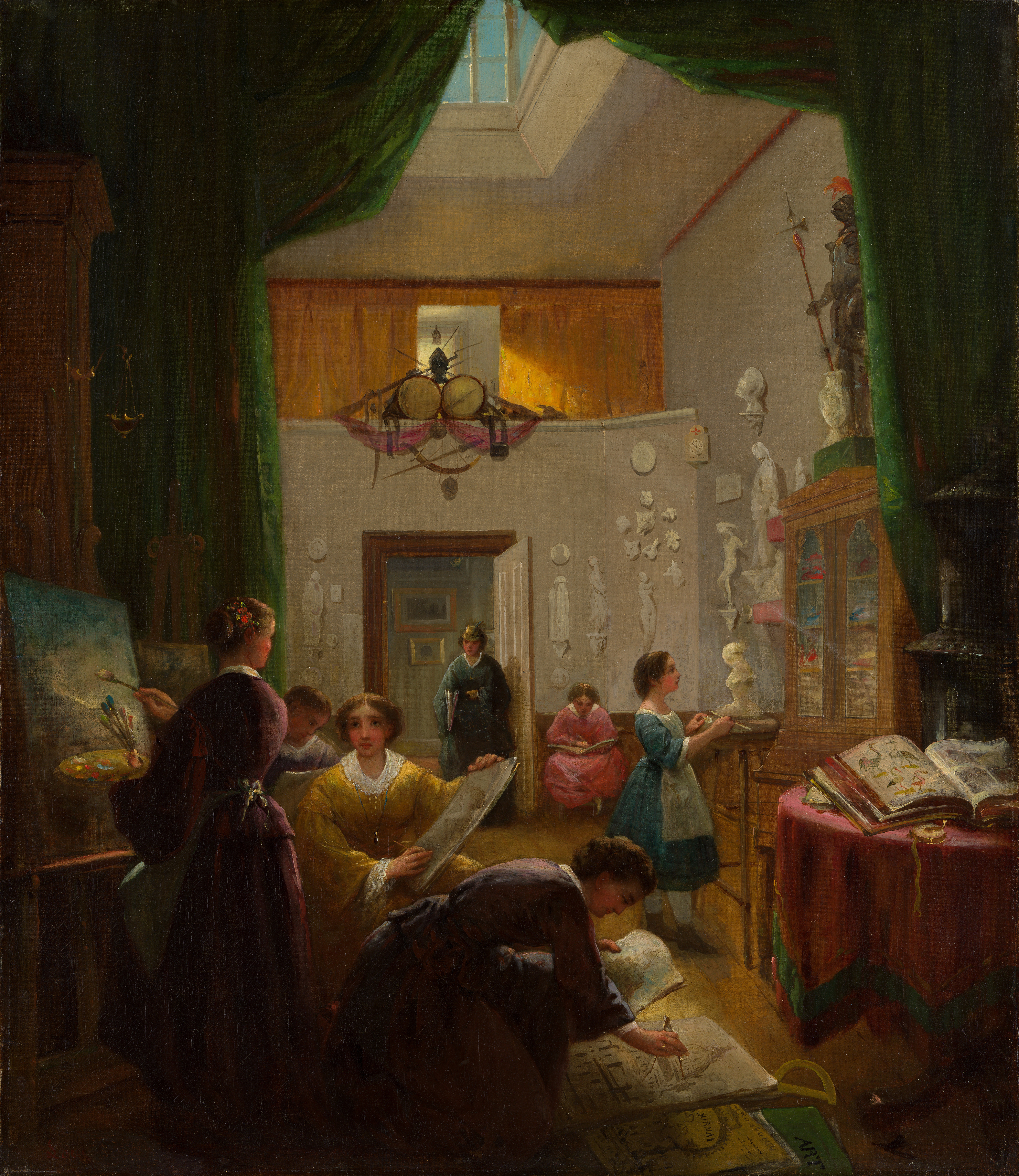
Louis Lang’s Art Students (ca. 1871) depicts six women industriously pursuing the arts of painting, sculpture, and drawing in a skylit studio. A seventh student enters the space, portfolio in hand, as a clock high on the wall signals that it is nearly 2 pm.
The students appear with varied essentials for artmaking: a palette and paints, canvas and paper, easels, and creative implements ranging from brushes, pens, and pencils to a compass and protractor.
Learning to paint and draw was considered fundamental to a refined young woman’s education. These abilities were often obtained through private classes, ladies’ academies, and instruction manuals.
For most of the nineteenth century, however, women who aspired to professional training in the fine arts had limited access to formal instruction.
By 1846, in New York, the National Academy of Design offered limited mixed-gender classes, though few women attended. In 1852, the New York School of Design for Women was founded.
By the late 1860s, educational opportunities for women had expanded. Private lessons were available with artists like Louis Lang and John La Farge. Schools such as the Cooper Union for the Advancement of Science and Art, established in 1859, and the Ladies Art Association, begun in 1867, offered vocational training for art teaching and various forms of illustration, decoration, and design, ranging from wood engraving to china painting.
Louis Lang (1814–1893) trained in his native Germany and Paris. He moved between Italy, France, and the United States, before finally settling in New York in 1849.
Lang regularly exhibited his paintings at prestigious venues such as the National Academy of Design. While not a household name today, he was prolific and esteemed during his lifetime, admired by patrons, critics, and fellow artists alike.

Unknown. [Louis Lang], 1860s. Albumen silver print, Approx. 10.2 x 6.3 cm (4 x 2 1/2 in.). The Metropolitan Museum of Art, New York, The Albert Ten Eyck Gardner Collection, Gift of the Centennial Committee, 1970 (1970.659.496)
Lang’s subject matter focuses on portraiture and history painting as well as sentimental narrative scenes depicting young, idealized women in picturesque natural surroundings—for instance The Basket Maker (1853), which entered The Met’s collection in 1877.
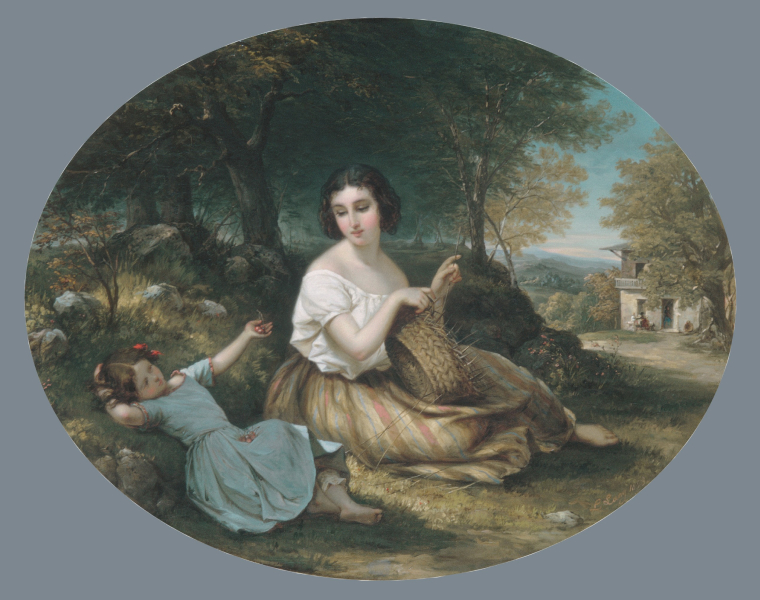
Louis Lang (American, 1814–1893). The Basket Maker, 1853. Oil on canvas, 27 1/4 x 34 1/4 in. (69.2 x 87 cm). The Metropolitan Museum of Art, New York, Bequest of Sarah Ann Ludlum, 1877 (77.3.4)
When The Met acquired Art Students in 1999, very little was known about it. The signature at lower left is only partially visible in red paint, since the remainder of the signature had been removed by strong solvents used to clean paintings in the past.
At the time of its acquisition, the painting was firmly attributed to Lang based on style and was assigned the descriptive title Women’s Art Class by curators. Only recently was it renamed to Art Students based on a list Lang recorded of works shown at a monthly reception at the Century Association on December 2, 1871, where the painting was described as “Art Students by L Lang, Interior of his ar [sic] space.”
The space represented is almost certainly in a building that once stood at 1193 Broadway and West 28th Street. There, Lang shared a suite of rooms with landscape painter John F. Kensett and portraitist George A. Baker.
The November 17, 1866, issue of Frank Leslie’s Weekly noted that Lang was making arrangements at this location for “a school for the instruction of young ladies in the arts of drawing and painting, the principles of which are to be conveyed in a practical and impressive manner.”
On January 27, 1867, Frank Leslie’s Illustrated Newspaper reported that the “School of Art for Ladies” had opened: “The apartments arranged by Mr. Lang for the instruction of ladies in the arts of painting, modeling and music, [sic] are very spacious and elegantly fitted up.” Lang was also an accomplished musician and taught lessons in composition.
In March 1867, American Art Journal recorded that the three artists “have just formed a most delightful art colony…, where they have pitched their easels, and surrounded themselves with all the elegances of modern beauty and improvement.”
Lang’s “elegantly fitted up” studio included a distinctive array of objects that created a cultured ambience.
In April 1872, prior to relocating to Italy for a prolonged stay, the artist auctioned off its contents at the Leavitt Art Rooms at 817 Broadway. The catalog of the two-day auction of “Mr. Lang’s Collection” lists 105 paintings by himself and others (though not Art Students).
It also provides useful descriptions of other items, including furniture, casts, armor, books, and costumes, some of which are on view in this painting.
In this context, Art Students serves as a manifesto of sorts from Lang’s years as an art instructor, as well as testament to artists’ often eclectic studio furnishings and props.
The suit of armor positioned on top of the glass-front chest and holding a sixteenth- or seventeenth-century staff weapon may date to the mid- to late-sixteenth century.
The 1872 auction catalog notes that Lang purchased the suit in London and that it was inlaid with gold, a detail visible on the loosely rendered surface.
Amid the panoply of objects above the doorway are eighteenth- and nineteenth-century straight and curved swords. Lang likely collected arms and armor across Europe and brought them to New York, as a dedicated American market for the art form did not develop until the 1870s.
Copying from plaster casts and design books was fundamental to nineteenth-century art instruction. Plaster casts sourced from Europe served as fundamental teaching tools; aspiring artists drew and modeled after casts of well-known works from antiquity and the Renaissance.
Between 1845 and 1847, when Lang was based in New York, he modeled plaster ornaments and figures for decorative purposes, so perhaps some of the items on the artfully arranged studio walls may represent his work.
Other casts of recognizable sculptures include the two robed figures flanking the door, modeled after alabaster statuettes of mourning monks from the tomb sculptures from the Court of Burgundy; now at Musée des Beaux-Arts, Dijon. Also featured are animal heads, full-length nudes, and portrait reliefs.
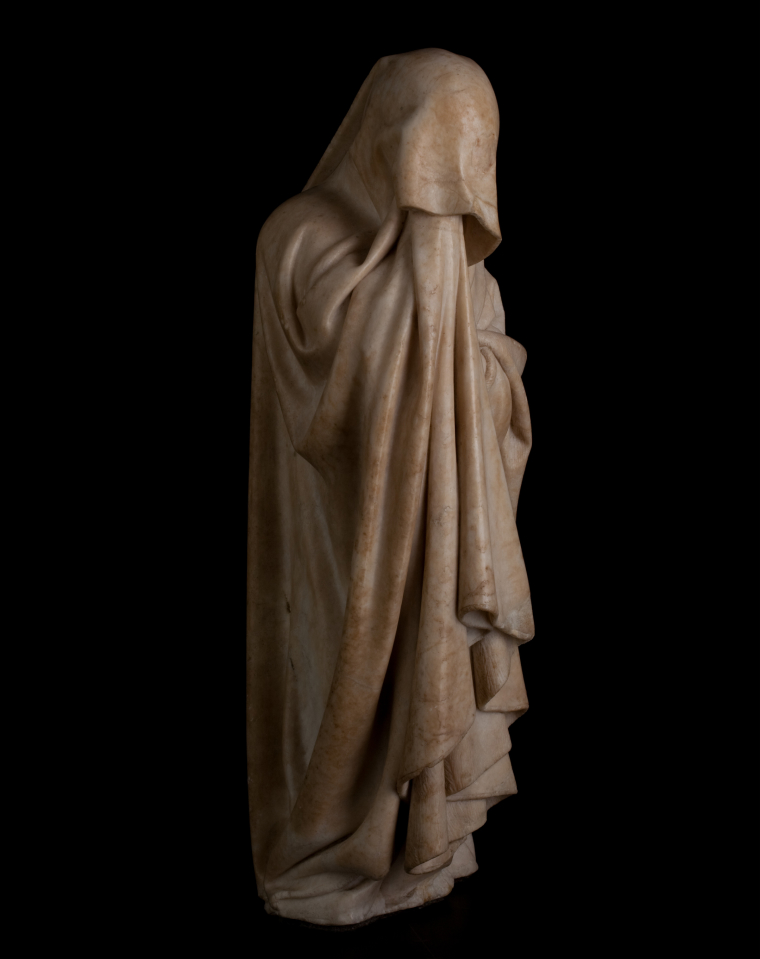
Jean de Marville (French, ?–1389); Claus Sluter (Netherlandish, ca. 1360–1406); Claus de Werve (Netherlandish, 1380–1439), Mourner no. 25 from Tomb of Philip the Bold, Duke of Burgundy, 1381–1410. Alabaster, Musée des Beaux-Arts, Dijon
The student in the foreground of the composition is using a compass to produce a scaled-up copy of a drawing of the U.S. Capitol dome in Washington, D.C.
The final section of Thomas Crawford’s bronze statue Freedom (1855–63), which surmounts the dome, was installed in December 1863, offering firm proof that this painting was completed after 1863.
Women art students were expected to pursue “acceptable” subjects, ranging from heads and figures to still lifes and landscapes, rather than historical themes. That kind of subject matter is apparent in the works being created in this painting.
The artist at the easel holding paint-laden brushes turns her head away from a vertical cloud-filled landscape to confer with the student in the yellow dress who holds up a nearly complete drawing of a bust-length head of a woman.
It is probable that the artist modeling a bust and the student drawing one are copying the same sculpture that is not visible, but rather located outside the picture plane in the viewer’s space.
Art students in these years would have had familiarity with plants and animals, as suggested by the inclusion of the illustrated volume on the table that features birds; by extension, it suggests that birds were among acceptable subjects for women to depict.
It is most likely that Lang fabricated the page to which the book is open—ornithological volumes this size usually featured a single bird, or at least a single species, on each page. Here, Lang created an imaginary pastiche showing four birds, each in its own space.
Three closely resemble those in John Gould’s five-volume The Birds of Europe, published in London between 1832 and 1837 and available to collectors by subscription. Edward Lear, a bird artist best known as the poet of “The Owl and the Pussycat,” produced illustrated plates for The Birds of Europe that correspond closely to three of the four birds on Lang’s imaginary page: the Common Crane and Common Heron are presented in mirror-image while the White Stork at lower left is more faithful to Lear’s original.
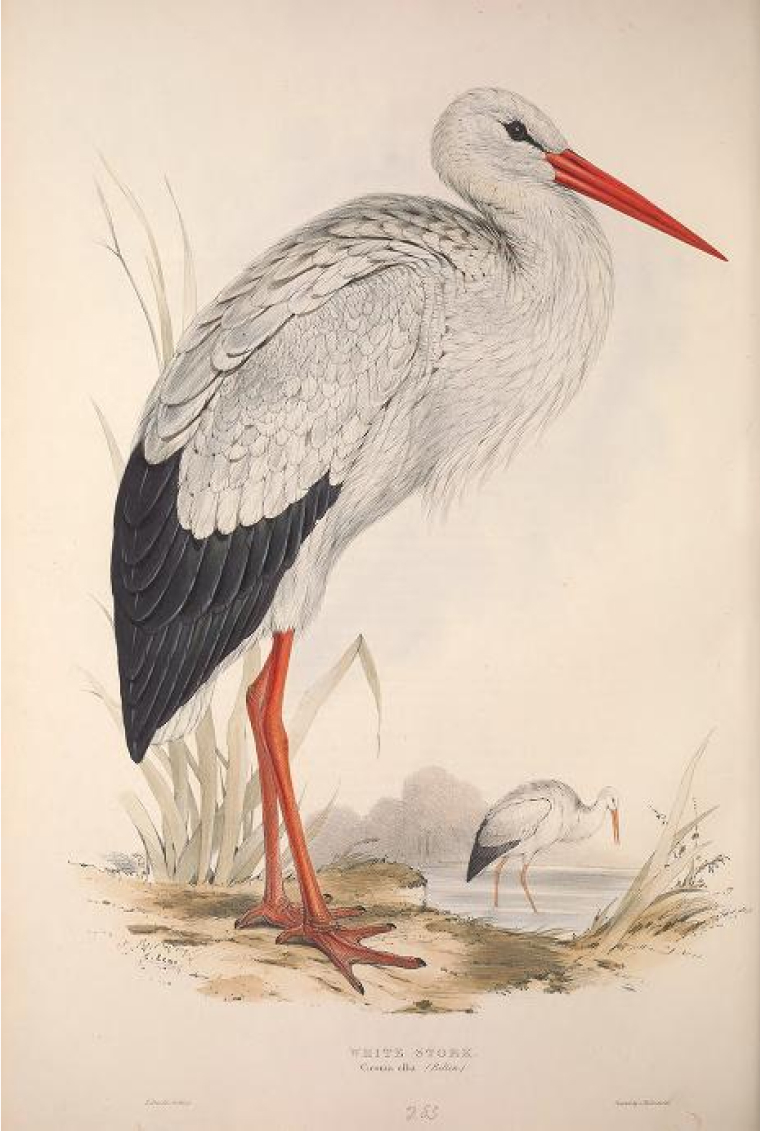
John Gould (1804–1881), Edward Lear (1812–1888). The Birds of Europe, vol. 4, plate 283. London, Printed by R. and J.E. Taylor, pub. by the author, 1837. Biodiversity Heritage Library, Smithsonian Libraries
The pink bird at lower right is likely a flamingo; however, it is not replicated after Lear’s version. Lang’s familiarity with the deluxe The Birds of Europe may have come through a New York patron or during his early career in Europe.
If Art Students dates to around 1871, why are the women wearing dresses that are considerably out of fashion for the time? Their attire, specifically the jacket bodices and wide sleeves, is more in keeping with styles from the late 1850s and early 1860s.
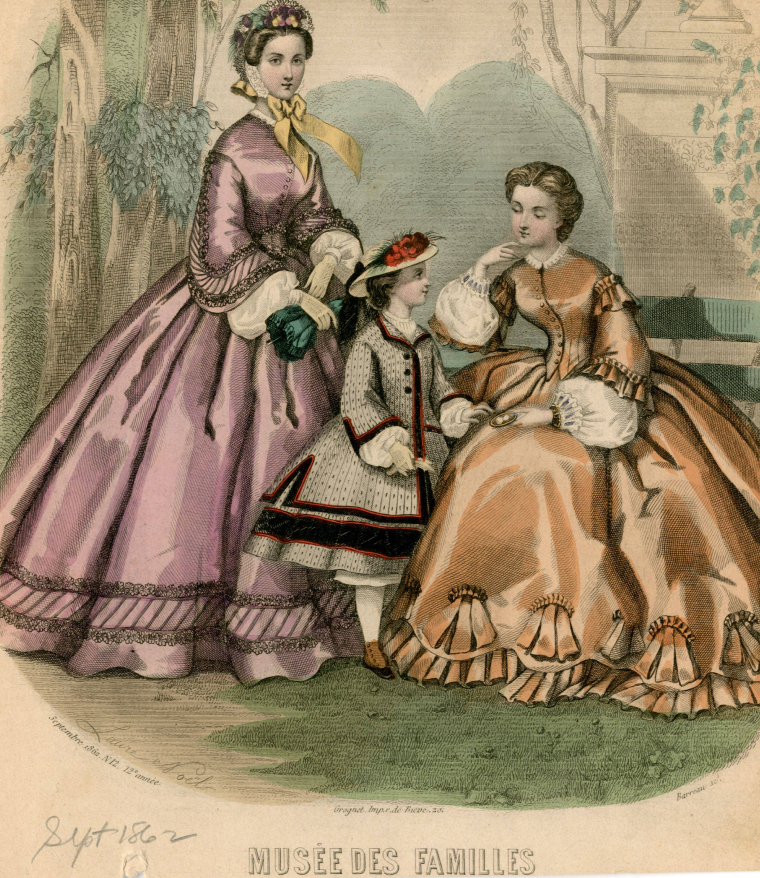
Women 1862, Plate 089, 1862. The Irene Lewisohn Costume Reference Library, The Costume Institute. The Metropolitan Museum of Art, New York. Gift of Woodman Thompson
The most smartly dressed student, who enters the studio, wears a cape with built-in sleeves and a pork-pie shaped hat more indicative of the late 1860s.

Women 1867, Plate 056, 1867. The Irene Lewisohn Costume Reference Library, The Costume Institute. The Metropolitan Museum of Art, New York. Gift of Lee Simonson
One explanation for Lang’s outdated fashion choices is indicated in the January 27, 1867, issue of Frank Leslie’s Illustrated Newspaper. Of the artist’s move to 1193 Broadway, the writer observed: “Few costumers could exhibit a greater variety of dresses than those belonging to the wardrobe of the lady known as the ‘lay figure’.”
A lay figure is a jointed mannequin of the human body upon which an artist arranges clothing and drapery. Lang plausibly selected from his impressive collection of dresses to portray the women in his highly constructed painting, indifferent to current fashions. The lay figure and costumes were listed among the items that he sold at auction in 1872.
Likewise, the hairstyles of these women, with hair secured low at the nape and full at the sides of the face, had been replaced by 1871 with higher, pulled-back arrangements.
The flowers in the painter’s hair are an unusual daytime artifice as they generally would have been worn to accessorize evening wear.
Indeed, many of the women that appear in Lang’s paintings throughout his career have similar hairstyles, round faces, and rosy cheeks, revealing that he was a seasoned portrayer of types, paying little attention to individuality or current trends.
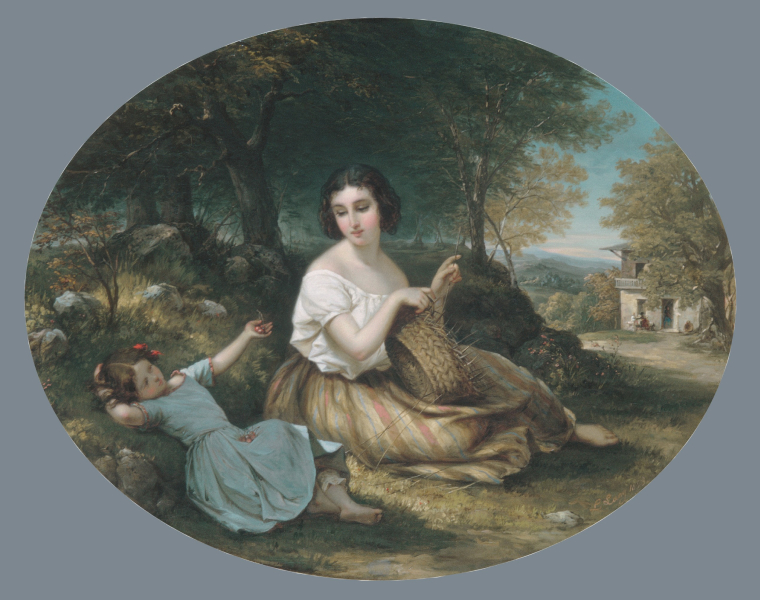
Louis Lang. The Basket Maker, 1853. The Metropolitan Museum of Art, New York
Lang not only took great care in detailing the studio’s occupants and contents, but also in rendering an interior that features intriguing spatial relationships.
A theatrically suspended green curtain divides the room, accentuating the contrast between the dimmer foreground and more dramatically lit background, with light streaming in through a window beyond the parted yellow curtain and a skylight propped open to the blue sky beyond. A wall between the main space and a hallway hung with paintings acts as both a divider and stage drop of sorts.
Pencil underdrawing is visible to the naked eye on the door, partition wall, and especially on the tall chest at right filled with studio bric-a-brac. Infrared reflectography, which allows us to see details under paint layers, reveals that Lang drew with a straight edge on a white ground to carefully establish the architectural structure of the room as well as the furniture and floorboards. He even drew in the beam of light streaming in from the lower window.
Only after establishing his setting did Lang freely paint the figures, curtains, and other narrative accoutrement.

Louis Lang. Art Students, infrared reflectogram. Department of Paintings Conservation, The Metropolitan Museum of Art
When Lang created Art Students around 1871, training opportunities for women were further expanding. This development is epitomized by a paint box with a nude study belonging to Helena de Kay.
In 1871, the National Academy of Design opened women-only classes for sketching live nude models, allowing them greater access to studying human anatomy. De Kay trained at the Academy as well as privately with John La Farge and Winslow Homer, creating still-life and figure paintings for public exhibition.
She was also a founder of the Art Students League in 1875.

Helena de Kay (American, 1846–1916). Paint box with nude study, ca. 1871. Oil on wood, 2 1/4 × 9 3/8 × 5 3/8 in. (5.7 × 23.8 × 13.7 cm). The Metropolitan Museum of Art, New York, Gift of Mary and William de Kay Pappenheimer, in celebration of the Museum's 150th anniversary, 2019 (2019.442.1)
From the 1870s on, women artists routinely studied in formal classroom settings like the Art Students League, following the most up-to-date curriculum offerings. Many of their classes were still single-sex, bound by conventions of decorum. They also exhibited their work at preeminent venues at home and abroad, including at world’s fairs such as the World’s Columbian Exposition in Chicago in 1893, the year of Lang’s death.
This landmark fair featured artwork by women in both the Fine Arts Building as well as the Woman’s Building, affirming a greater acceptance of the creative practice of women artists that Lang highlighted in Art Students more than twenty years earlier.
Acknowledgments
The Metropolitan Museum of Art
Amelia Peck and Sylvia Yount, The American Wing
John Byck, Stuart Pyhrr, and Donald LaRocca, Arms and Armor
Julie T. Lê and Marci Morimoto, The Costume Institute
Dorothy Mahon and Evan Read, Paintings Conservation
Academy of Natural Sciences of Drexel University
Robert M. Peck
American Museum of Natural History
Thomas Baione and Roger Pasquier
The Century Association
Celestina Cuadrado
Century Association Archives Foundation
Brynn White
College of the Holy Cross
Melissa Geisler Trafton
Image Credits
Louis Lang (American, 1814–1893). Art Students, ca. 1871. Oil on canvas, 26 7/8 x 23 1/4 in. (68.3 x 59.1 cm). The Metropolitan Museum of Art, New York, Morris K. Jesup Fund, 1999 (1999.143)
Unknown. [Louis Lang], 1860s. Albumen silver print, Approx. 10.2 x 6.3 cm (4 x 2 1/2 in.). The Metropolitan Museum of Art, New York, The Albert Ten Eyck Gardner Collection, Gift of the Centennial Committee, 1970 (1970.659.496)
Louis Lang (American, 1814–1893). The Basket Maker, 1853. Oil on canvas, 27 1/4 x 34 1/4 in. (69.2 x 87 cm). The Metropolitan Museum of Art, New York, Bequest of Sarah Ann Ludlum, 1877 (77.3.4)
Jean de Marville (French, ?–1389); Claus Sluter (Netherlandish, ca. 1360–1406); Claus de Werve (Netherlandish, 1380–1439), Mourner no. 25 from Tomb of Philip the Bold, Duke of Burgundy, 1381–1410. Alabaster, Musée des Beaux-Arts, Dijon
John Gould (1804–1881), Edward Lear (1812–1888). The Birds of Europe, vol. 4, plate 283. London, Printed by R. and J.E. Taylor, pub. by the author, 1837. Biodiversity Heritage Library, Smithsonian Libraries

